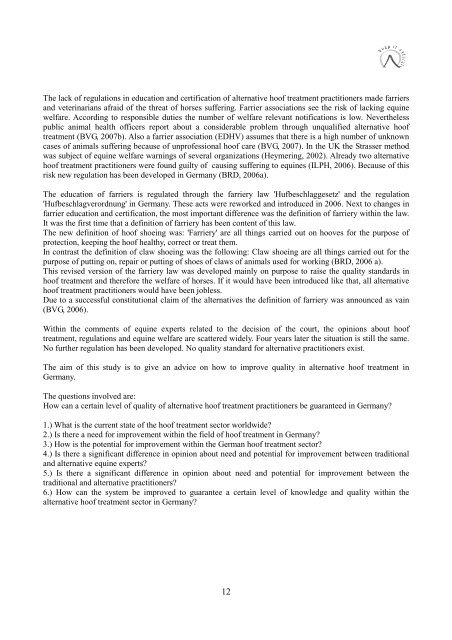Bachelor Thesis - Christina Kuenen - Hufpfleger
Bachelor Thesis - Christina Kuenen - Hufpfleger
Bachelor Thesis - Christina Kuenen - Hufpfleger
You also want an ePaper? Increase the reach of your titles
YUMPU automatically turns print PDFs into web optimized ePapers that Google loves.
The lack of regulations in education and certification of alternative hoof treatment practitioners made farriers<br />
and veterinarians afraid of the threat of horses suffering. Farrier associations see the risk of lacking equine<br />
welfare. According to responsible duties the number of welfare relevant notifications is low. Nevertheless<br />
public animal health officers report about a considerable problem through unqualified alternative hoof<br />
treatment (BVG, 2007b). Also a farrier association (EDHV) assumes that there is a high number of unknown<br />
cases of animals suffering because of unprofessional hoof care (BVG, 2007). In the UK the Strasser method<br />
was subject of equine welfare warnings of several organizations (Heymering, 2002). Already two alternative<br />
hoof treatment practitioners were found guilty of causing suffering to equines (ILPH, 2006). Because of this<br />
risk new regulation has been developed in Germany (BRD, 2006a).<br />
The education of farriers is regulated through the farriery law 'Hufbeschlaggesetz' and the regulation<br />
'Hufbeschlagverordnung' in Germany. These acts were reworked and introduced in 2006. Next to changes in<br />
farrier education and certification, the most important difference was the definition of farriery within the law.<br />
It was the first time that a definition of farriery has been content of this law.<br />
The new definition of hoof shoeing was: 'Farriery' are all things carried out on hooves for the purpose of<br />
protection, keeping the hoof healthy, correct or treat them.<br />
In contrast the definition of claw shoeing was the following: Claw shoeing are all things carried out for the<br />
purpose of putting on, repair or putting of shoes of claws of animals used for working (BRD, 2006 a).<br />
This revised version of the farriery law was developed mainly on purpose to raise the quality standards in<br />
hoof treatment and therefore the welfare of horses. If it would have been introduced like that, all alternative<br />
hoof treatment practitioners would have been jobless.<br />
Due to a successful constitutional claim of the alternatives the definition of farriery was announced as vain<br />
(BVG, 2006).<br />
Within the comments of equine experts related to the decision of the court, the opinions about hoof<br />
treatment, regulations and equine welfare are scattered widely. Four years later the situation is still the same.<br />
No further regulation has been developed. No quality standard for alternative practitioners exist.<br />
The aim of this study is to give an advice on how to improve quality in alternative hoof treatment in<br />
Germany.<br />
The questions involved are:<br />
How can a certain level of quality of alternative hoof treatment practitioners be guaranteed in Germany?<br />
1.) What is the current state of the hoof treatment sector worldwide?<br />
2.) Is there a need for improvement within the field of hoof treatment in Germany?<br />
3.) How is the potential for improvement within the German hoof treatment sector?<br />
4.) Is there a significant difference in opinion about need and potential for improvement between traditional<br />
and alternative equine experts?<br />
5.) Is there a significant difference in opinion about need and potential for improvement between the<br />
traditional and alternative practitioners?<br />
6.) How can the system be improved to guarantee a certain level of knowledge and quality within the<br />
alternative hoof treatment sector in Germany?<br />
12


